Android 16 มาพร้อมฟีเจอร์และ API ใหม่ๆ ที่ยอดเยี่ยมสำหรับนักพัฒนาแอป ส่วนต่อไปนี้ จะสรุปฟีเจอร์เหล่านี้เพื่อช่วยให้คุณเริ่มต้นใช้งาน API ที่เกี่ยวข้องได้
หากต้องการดูรายการ API ใหม่ที่มีการแก้ไขและนำออกโดยละเอียด โปรดอ่านรายงานความแตกต่างของ API ดูรายละเอียดเกี่ยวกับ API ใหม่ได้ที่เอกสารอ้างอิง Android API โดยเราจะไฮไลต์ API ใหม่เพื่อให้มองเห็นได้ชัดเจนนอกจากนี้ คุณควรตรวจสอบส่วนที่การเปลี่ยนแปลงของแพลตฟอร์มอาจส่งผลต่อแอปด้วย ดูข้อมูลเพิ่มเติมได้ที่หน้าต่อไปนี้
- การเปลี่ยนแปลงลักษณะการทำงานที่มีผลกับแอปเมื่อกำหนดเป้าหมายเป็น Android 16
- การเปลี่ยนแปลงลักษณะการทำงานที่มีผลกับแอปทั้งหมดโดยไม่คำนึงถึง
targetSdkVersion
ฟังก์ชันหลัก
Android มี API ใหม่ๆ ที่ขยายความสามารถหลักของระบบ Android
การเปิดตัว Android API 2 รายการในปี 2025
- This preview is for the next major release of Android with a planned launch in Q2 of 2025. This release is similar to all of our API releases in the past, where we can have planned behavior changes that are often tied to a targetSdkVersion.
- We're planning the major release a quarter earlier (Q2 rather than Q3 in prior years) to better align with the schedule of device launches across our ecosystem, so more devices can get the major release of Android sooner. With the major release coming in Q2, you'll need to do your annual compatibility testing a few months earlier than in previous years to make sure your apps are ready.
- We plan to have another release in Q4 of 2025 which also will include new developer APIs. The Q2 major release will be the only release in 2025 to include planned behavior changes that could affect apps.
In addition to new developer APIs, the Q4 minor release will pick up feature updates, optimizations, and bug fixes; it will not include any app-impacting behavior changes.

We'll continue to have quarterly Android releases. The Q1 and Q3 updates in-between the API releases will provide incremental updates to help ensure continuous quality. We're actively working with our device partners to bring the Q2 release to as many devices as possible.
Using new APIs with major and minor releases
Guarding a code block with a check for API level is done today using
the SDK_INT constant with
VERSION_CODES. This will continue
to be supported for major Android releases.
if (SDK_INT >= VERSION_CODES.BAKLAVA) {
// Use APIs introduced in Android 16
}
The new SDK_INT_FULL
constant can be used for API checks against both major and minor versions with
the new VERSION_CODES_FULL
enumeration.
if (SDK_INT_FULL >= VERSION_CODES_FULL.[MAJOR or MINOR RELEASE]) {
// Use APIs introduced in a major or minor release
}
You can also use the
Build.getMinorSdkVersion()
method to get just the minor SDK version.
val minorSdkVersion = Build.getMinorSdkVersion(VERSION_CODES_FULL.BAKLAVA)
These APIs have not yet been finalized and are subject to change, so please send us feedback if you have any concerns.
ประสบการณ์ของผู้ใช้และ UI ของระบบ
Android 16 ช่วยให้นักพัฒนาแอปและผู้ใช้ควบคุมและปรับแต่ง การกำหนดค่าอุปกรณ์ให้เหมาะกับความต้องการได้มากขึ้น
การแจ้งเตือนที่เน้นความคืบหน้า
Android 16 introduces progress-centric notifications to help users seamlessly track user-initiated, start-to-end journeys.
Notification.ProgressStyle is a new notification
style that lets you create progress-centric notifications. Key use cases include
rideshare, delivery, and navigation. Within the Notification.ProgressStyle
class, you can denote states and milestones in a user journey using
points and segments.
ดูข้อมูลเพิ่มเติมได้ที่หน้าเอกสารประกอบเกี่ยวกับการแจ้งเตือนที่เน้นความคืบหน้า
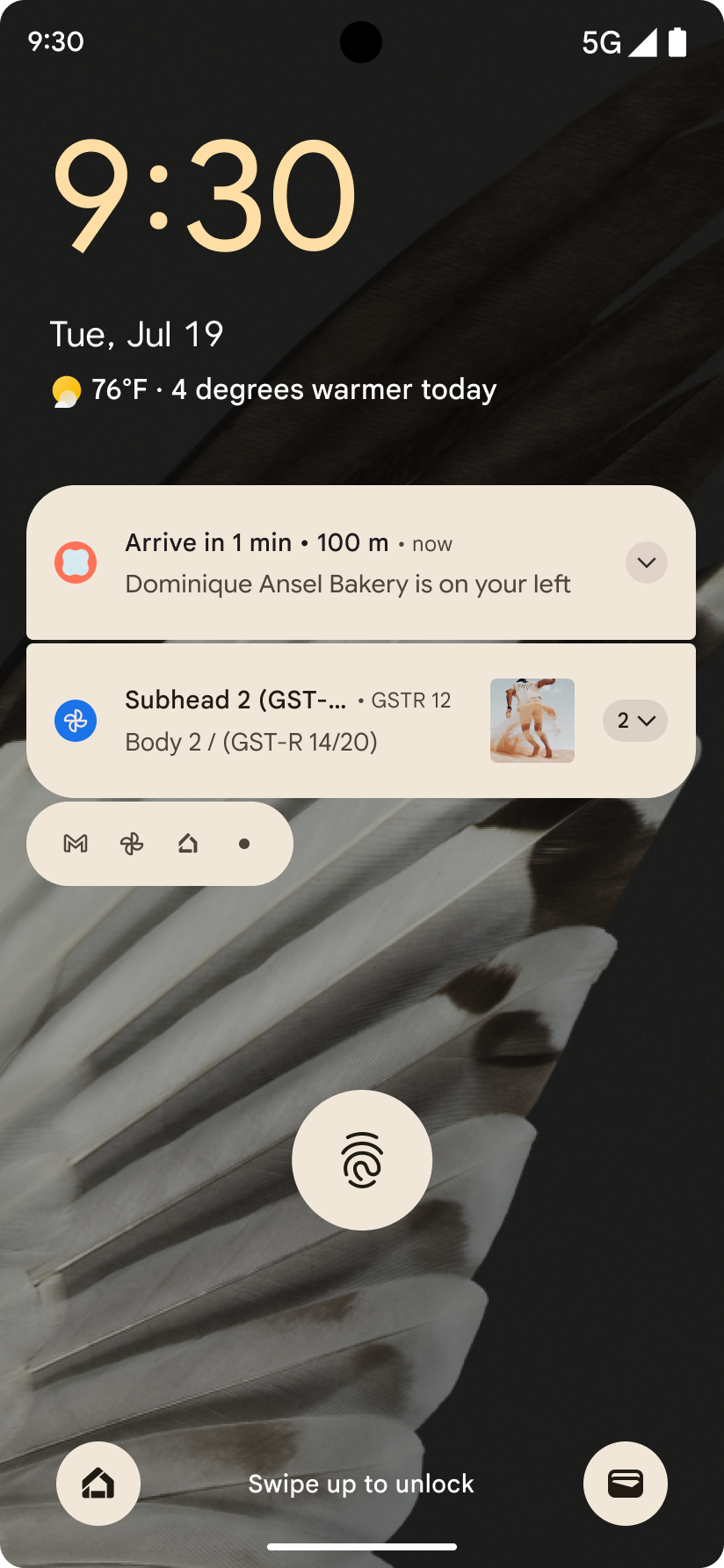
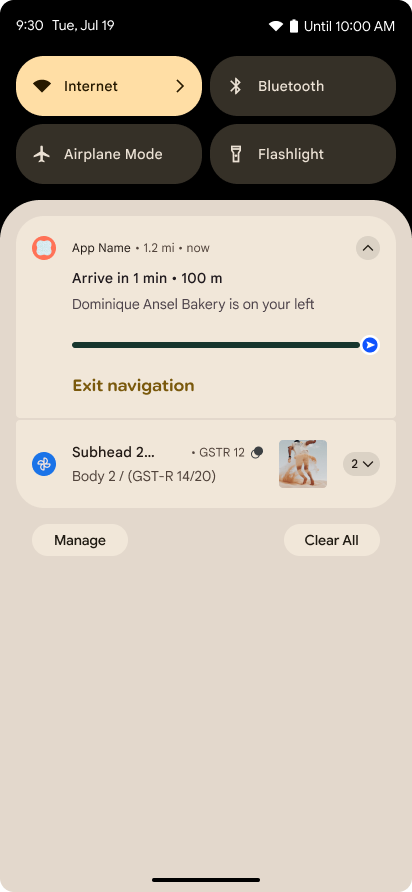
การอัปเดตการย้อนกลับที่คาดการณ์ได้
Android 16 adds new APIs to help you enable predictive back system animations in
gesture navigation such as the back-to-home animation. Registering the
onBackInvokedCallback with the new
PRIORITY_SYSTEM_NAVIGATION_OBSERVER allows your app to
receive the regular onBackInvoked call whenever the
system handles a back navigation without impacting the normal back navigation
flow.
Android 16 additionally adds the
finishAndRemoveTaskCallback() and
moveTaskToBackCallback. By registering these callbacks
with the OnBackInvokedDispatcher, the system can trigger
specific behaviors and play corresponding ahead-of-time animations when the back
gesture is invoked.
การโต้ตอบการสัมผัสที่ละเอียดยิ่งขึ้น
Android has exposed control over the haptic actuator ever since its inception.
Android 11 added support for more complex haptic effects that more advanced
actuators could support through
VibrationEffect.Compositions of device-defined semantic
primitives.
Android 16 adds haptic APIs that let apps define the amplitude and frequency curves of a haptic effect while abstracting away differences between device capabilities.
ประสิทธิภาพการทำงานและเครื่องมือสำหรับนักพัฒนาซอฟต์แวร์
แม้ว่างานส่วนใหญ่ของเราในการปรับปรุงประสิทธิภาพการทำงานของคุณจะมุ่งเน้นไปที่เครื่องมือต่างๆ เช่น Android Studio, Jetpack Compose และไลบรารี Android Jetpack แต่เราก็มองหาวิธีต่างๆ ในแพลตฟอร์มเพื่อช่วยให้คุณตระหนักถึงวิสัยทัศน์ของคุณอยู่เสมอ
การจัดการเนื้อหาสำหรับวอลเปเปอร์เคลื่อนไหว
In Android 16, the live wallpaper framework is gaining a new content API to
address the challenges of dynamic, user-driven wallpapers. Currently, live
wallpapers incorporating user-provided content require complex, service-specific
implementations. Android 16 introduces
WallpaperDescription and
WallpaperInstance. WallpaperDescription lets you
identify distinct instances of a live wallpaper from the same service. For
example, a wallpaper that has instances on both the home screen and on the lock
screen may have unique content in both places. The wallpaper picker and
WallpaperManager use this metadata to better present
wallpapers to users, streamlining the process for you to create diverse and
personalized live wallpaper experiences.
ประสิทธิภาพและแบตเตอรี่
Android 16 เปิดตัว API ที่ช่วยรวบรวมข้อมูลเชิงลึกเกี่ยวกับแอปของคุณ
การทำโปรไฟล์ที่ระบบทริกเกอร์
ProfilingManager เพิ่มเข้ามาใน Android 15 ซึ่งช่วยให้แอปสามารถส่งคําขอรวบรวมข้อมูลการจัดทำโปรไฟล์โดยใช้ Perfetto ในอุปกรณ์สาธารณะในสนามได้
อย่างไรก็ตาม เนื่องจากต้องเริ่มการโปรไฟล์นี้จากแอป แอปจึงอาจจับภาพขั้นตอนสําคัญ เช่น การเริ่มต้นหรือ ANR ได้ยากหรือเป็นไปไม่ได้
Android 16 เปิดตัวการโปรไฟล์ที่ระบบทริกเกอร์เพื่อแก้ปัญหานี้ใน ProfilingManager แอปสามารถลงทะเบียนความสนใจในการรับการติดตามสำหรับทริกเกอร์บางอย่าง เช่น Cold Start reportFullyDrawn หรือ ANR จากนั้นระบบจะเริ่มและหยุดการติดตามในนามของแอป หลังจากการติดตามเสร็จสมบูรณ์แล้ว ระบบจะส่งผลลัพธ์ไปยังไดเรกทอรีข้อมูลของแอป
เริ่มคอมโพเนนต์ใน ApplicationStartInfo
ApplicationStartInfo was added in Android
15, allowing an app to see reasons
for process start, start type, start times, throttling, and other useful
diagnostic data. Android 16 adds
getStartComponent()
to distinguish what component type triggered the start, which can be helpful for
optimizing the startup flow of your app.
การตรวจสอบงานที่ดีขึ้น
The JobScheduler#getPendingJobReason() API returns a reason why a job
might be pending. However, a job might be pending for multiple reasons.
In Android 16, we are introducing a new API
JobScheduler#getPendingJobReasons(int jobId), which returns multiple
reasons why a job is pending, due to both explicit constraints set by the
developer and implicit constraints set by the system.
We're also introducing
JobScheduler#getPendingJobReasonsHistory(int jobId), which returns a list
of the most recent constraint changes.
We recommend using the API to help you debug why your jobs may not be executing, especially if you're seeing reduced success rates of certain tasks or have bugs around latency of certain job completion. For example, updating widgets in the background failed to occur or prefetch job failed to be called prior to app start.
This can also better help you understand if certain jobs are not completing due to system defined constraints versus explicitly set constraints.
อัตราการรีเฟรชแบบปรับอัตโนมัติ
Adaptive refresh rate (ARR), introduced in Android 15, enables the display refresh rate on supported hardware to adapt to the content frame rate using discrete VSync steps. This reduces power consumption while eliminating the need for potentially jank-inducing mode-switching.
Android 16 introduces hasArrSupport() and
getSuggestedFrameRate(int) while restoring
getSupportedRefreshRates() to make it easier for your apps to take
advantage of ARR. RecyclerView
1.4 internally supports ARR when it is settling from a fling or
smooth scroll, and we're continuing our work to add ARR
support into more Jetpack libraries. This frame rate article covers
many of the APIs you can use to set the frame rate so that your app can directly
use ARR.
API พื้นที่ว่างใน ADPF
The SystemHealthManager introduces the
getCpuHeadroom and
getGpuHeadroom APIs, designed to provide games and
resource-intensive apps with estimates of available CPU and GPU resources. These
methods offer a way for you to gauge how your app or game can best improve
system health, particularly when used in conjunction with other Android Dynamic
Performance Framework (ADPF) APIs that detect thermal
throttling.
By using CpuHeadroomParams and
GpuHeadroomParams on supported devices, you can
customize the time window used to compute the headroom and select between
average or minimum resource availability. This can help you reduce your CPU or
GPU resource usage accordingly, leading to better user experiences and improved
battery life.
การช่วยเหลือพิเศษ
Android 16 เพิ่ม API และฟีเจอร์การช่วยเหลือพิเศษใหม่ๆ ที่จะช่วยให้คุณนำแอปไปสู่ผู้ใช้ทุกคนได้
API การช่วยเหลือพิเศษที่ได้รับการปรับปรุง
Android 16 เพิ่ม API เพิ่มเติมเพื่อปรับปรุงความหมายของ UI ซึ่งจะช่วยเพิ่มความสอดคล้องสำหรับผู้ใช้ที่อาศัยบริการช่วยเหลือพิเศษ เช่น TalkBack
ขีดเส้นขอบข้อความเพื่อให้ข้อความมีความคมชัดสูงสุด
ผู้ใช้ที่มีความบกพร่องทางการมองเห็นมักมีความไวต่อคอนทราสต์ลดลง ทำให้แยกแยะวัตถุออกจากพื้นหลังได้ยาก Android 16 เปิดตัวข้อความขอบแทนที่ข้อความคอนทราสต์สูงเพื่อช่วยผู้ใช้เหล่านี้ ซึ่งจะวาดพื้นที่คอนทราสต์ขนาดใหญ่ขึ้นรอบข้อความเพื่อปรับปรุงความสามารถในการอ่านได้อย่างมาก
Android 16 มี API AccessibilityManager ใหม่เพื่อให้แอปตรวจสอบหรือลงทะเบียนโปรแกรมฟังเพื่อดูว่าเปิดใช้โหมดนี้หรือไม่ การดำเนินการนี้มีไว้สำหรับชุดเครื่องมือ UI เช่น Compose เป็นหลัก เพื่อมอบประสบการณ์การรับชมที่คล้ายกัน หากคุณดูแลรักษาไลบรารี UI Toolkit หรือแอปของคุณแสดงผลข้อความที่กำหนดเองซึ่งข้ามคลาส android.text.Layout คุณสามารถใช้แอตทริบิวต์นี้เพื่อดูว่าเปิดใช้ข้อความขอบหรือไม่
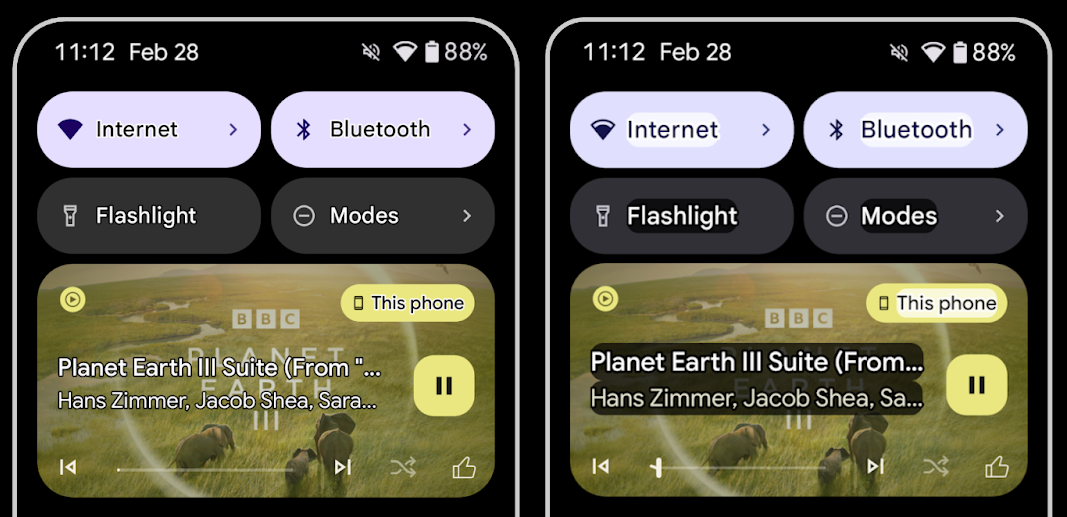
เพิ่มระยะเวลาลงใน TtsSpan
Android 16 ขยาย TtsSpan ด้วย TYPE_DURATION ซึ่งประกอบด้วย ARG_HOURS, ARG_MINUTES และ ARG_SECONDS ซึ่งจะช่วยให้คุณกำกับเวลาได้โดยตรง เพื่อให้เอาต์พุตการอ่านออกเสียงข้อความมีความแม่นยำและสอดคล้องกันกับบริการต่างๆ เช่น TalkBack
รองรับองค์ประกอบที่มีป้ายกำกับหลายรายการ
ปัจจุบัน Android อนุญาตให้องค์ประกอบ UI ดึงข้อมูลป้ายกำกับการช่วยเหลือพิเศษจากองค์ประกอบอื่น และตอนนี้สามารถเชื่อมโยงป้ายกำกับหลายรายการเข้าด้วยกันได้แล้ว ซึ่งเป็นสถานการณ์ที่พบได้ทั่วไปในเนื้อหาเว็บ การใช้ API ตามรายการภายใน AccessibilityNodeInfo จะช่วยให้ Android รองรับความสัมพันธ์แบบหลายป้ายกำกับเหล่านี้ได้โดยตรง การเปลี่ยนแปลงนี้ทำให้เราเลิกใช้งาน AccessibilityNodeInfo#setLabeledBy และ #getLabeledBy แล้วหันมาใช้ #addLabeledBy, #removeLabeledBy และ #getLabeledByList แทน
ปรับปรุงการรองรับองค์ประกอบแบบขยายได้
Android 16 เพิ่ม API การช่วยเหลือพิเศษที่ช่วยให้คุณสื่อสถานะแบบขยายหรือยุบขององค์ประกอบแบบอินเทอร์แอกทีฟ เช่น เมนูและรายการแบบขยายได้ การตั้งค่าสถานะแบบขยายโดยใช้ setExpandedState และการส่ง TYPE_WINDOW_CONTENT_CHANGED AccessibilityEvents ด้วยประเภทการเปลี่ยนแปลงเนื้อหา CONTENT_CHANGE_TYPE_EXPANDED จะช่วยให้มั่นใจได้ว่าโปรแกรมอ่านหน้าจออย่าง TalkBack จะประกาศการเปลี่ยนแปลงสถานะ ซึ่งมอบประสบการณ์การใช้งานที่ใช้งานง่ายและครอบคลุมมากขึ้นแก่ผู้ใช้
แถบความคืบหน้าที่ระบุสถานะไม่ได้
Android 16 เพิ่ม RANGE_TYPE_INDETERMINATE ซึ่งช่วยให้คุณแสดง RangeInfo สำหรับวิดเจ็ต ProgressBar ทั้งแบบกำหนดได้และแบบกำหนดไม่ได้ ซึ่งช่วยให้บริการอย่าง TalkBack แสดงความคิดเห็นสำหรับตัวบ่งชี้ความคืบหน้าได้อย่างสม่ำเสมอมากขึ้น
ช่องทำเครื่องหมายแบบ 3 สถานะ
ตอนนี้เมธอด AccessibilityNodeInfo
getChecked และ setChecked(int) แบบใหม่ใน Android 16 รองรับสถานะ "เลือกบางส่วน" นอกเหนือจาก "เลือก" และ "ยกเลิกการเลือก" แล้ว ซึ่งมาแทนที่บูลีน isChecked และ setChecked(boolean) ที่เลิกใช้งานแล้ว
คำอธิบายเพิ่มเติม
เมื่อบริการการช่วยเหลือพิเศษอธิบาย ViewGroup บริการจะรวมป้ายกำกับเนื้อหาจากมุมมองย่อย หากคุณระบุ contentDescription สำหรับ ViewGroup บริการการช่วยเหลือพิเศษจะถือว่าคุณลบล้างคำอธิบายของมุมมองย่อยที่โฟกัสไม่ได้ด้วย ซึ่งอาจทำให้เกิดปัญหาหากคุณต้องการติดป้ายกำกับรายการต่างๆ เช่น เมนูแบบเลื่อนลง (เช่น "ตระกูลแบบอักษร") ขณะเก็บค่าที่เลือกไว้ในปัจจุบันไว้สำหรับการช่วยเหลือพิเศษ (เช่น "Roboto") Android 16 เพิ่ม setSupplementalDescription เพื่อให้คุณระบุข้อความที่ให้ข้อมูลเกี่ยวกับ ViewGroup ได้โดยไม่ต้องลบล้างข้อมูลจากรายการย่อย
ฟิลด์ในแบบฟอร์มที่ต้องกรอก
Android 16 เพิ่ม setFieldRequired ลงใน AccessibilityNodeInfo เพื่อให้แอปบอกบริการการช่วยเหลือพิเศษได้ว่าต้องป้อนข้อมูลในช่องแบบฟอร์ม นี่เป็นสถานการณ์ที่สําคัญสําหรับผู้ใช้ที่กรอกแบบฟอร์มหลายประเภท แม้กระทั่งสิ่งง่ายๆ อย่างช่องทําเครื่องหมายข้อกําหนดและเงื่อนไขที่จําเป็น ซึ่งช่วยให้ผู้ใช้ระบุและไปยังช่องที่ต้องกรอกต่างๆ ได้อย่างรวดเร็วอย่างสม่ำเสมอ
โทรศัพท์เป็นอินพุตไมโครโฟนสำหรับการโทรด้วยเสียงผ่านเครื่องช่วยฟัง LEA
Android 16 adds the capability for users of LE Audio hearing aids to switch between the built-in microphones on the hearing aids and the microphone on their phone for voice calls. This can be helpful in noisy environments or other situations where the hearing aid's microphones might not perform well.
การควบคุมระดับเสียงโดยรอบสำหรับเครื่องช่วยฟัง LEA
Android 16 เพิ่มความสามารถในการปรับระดับเสียงของเสียงรอบข้างที่ไมโครโฟนของเครื่องช่วยฟังตรวจพบให้แก่ผู้ใช้เครื่องช่วยฟัง LE Audio ซึ่งจะมีประโยชน์ในสถานการณ์ที่มีเสียงรบกวนรอบข้างดังหรือเบาเกินไป
กล้อง
Android 16 จะเพิ่มการรองรับผู้ใช้กล้องระดับมืออาชีพ โดยอนุญาตให้ใช้การเปิดรับแสงอัตโนมัติแบบไฮบริด
พร้อมกับการปรับอุณหภูมิสีและสีอย่างแม่นยำ ตัวบ่งชี้โหมดกลางคืนแบบใหม่จะช่วยให้แอปทราบเวลาที่จะเปลี่ยนเป็นและออกจากเซสชันกล้องในโหมดกลางคืน Intentการดำเนินการใหม่ๆ ช่วยให้คุณถ่ายภาพเคลื่อนไหวได้ง่ายขึ้น
และเราจะปรับปรุงรูปภาพ UltraHDR ต่อไปโดยรองรับการเข้ารหัส HEIC
และพารามิเตอร์ใหม่จากมาตรฐานฉบับร่าง ISO 21496-1
การรับแสงอัตโนมัติแบบผสม
Android 16 เพิ่มโหมดการเปิดรับแสงอัตโนมัติแบบผสมใหม่ลงใน Camera2 ซึ่งช่วยให้คุณควบคุมแง่มุมต่างๆ ของการเปิดรับแสงด้วยตนเองได้ขณะที่อัลกอริทึมการเปิดรับแสงอัตโนมัติ (AE) จัดการส่วนที่เหลือ คุณสามารถควบคุมISO + AE และเวลาเปิดรับแสง + AE ซึ่งให้ความยืดหยุ่นมากกว่าแนวทางปัจจุบันที่คุณต้องควบคุมด้วยตนเองทั้งหมดหรือใช้การเปิดรับแสงอัตโนมัติทั้งหมด
fun setISOPriority() {
// ... (Your existing code before the snippet) ...
val availablePriorityModes = mStaticInfo.characteristics.get(
CameraCharacteristics.CONTROL_AE_AVAILABLE_PRIORITY_MODES
)
// ... (Your existing code between the snippets) ...
// Turn on AE mode to set priority mode
reqBuilder.set(
CaptureRequest.CONTROL_AE_MODE,
CameraMetadata.CONTROL_AE_MODE_ON
)
reqBuilder.set(
CaptureRequest.CONTROL_AE_PRIORITY_MODE,
CameraMetadata.CONTROL_AE_PRIORITY_MODE_SENSOR_SENSITIVITY_PRIORITY
)
reqBuilder.set(
CaptureRequest.SENSOR_SENSITIVITY,
TEST_SENSITIVITY_VALUE
)
val request: CaptureRequest = reqBuilder.build()
// ... (Your existing code after the snippet) ...
}
การปรับอุณหภูมิสีและสีอย่างแม่นยำ
Android 16 เพิ่มการรองรับกล้องสำหรับการปรับอุณหภูมิสีและการปรับสีเล็กน้อยเพื่อรองรับแอปพลิเคชันการบันทึกวิดีโอระดับมืออาชีพได้ดียิ่งขึ้น ใน Android เวอร์ชันก่อนหน้า คุณสามารถควบคุมการตั้งค่าสมดุลแสงสีขาวผ่าน CONTROL_AWB_MODE ซึ่งมีตัวเลือกที่จํากัดอยู่ในรายการที่กำหนดล่วงหน้า เช่น หลอดไส้ เมฆมาก และช่วงพลบค่ำ COLOR_CORRECTION_MODE_CCT ช่วยให้สามารถใช้ COLOR_CORRECTION_COLOR_TEMPERATURE และ COLOR_CORRECTION_COLOR_TINT เพื่อปรับสมดุลสีขาวได้อย่างแม่นยำตามอุณหภูมิสีที่เกี่ยวข้อง
fun setCCT() {
// ... (Your existing code before this point) ...
val colorTemperatureRange: Range<Int> =
mStaticInfo.characteristics[CameraCharacteristics.COLOR_CORRECTION_COLOR_TEMPERATURE_RANGE]
// Set to manual mode to enable CCT mode
reqBuilder[CaptureRequest.CONTROL_AWB_MODE] = CameraMetadata.CONTROL_AWB_MODE_OFF
reqBuilder[CaptureRequest.COLOR_CORRECTION_MODE] = CameraMetadata.COLOR_CORRECTION_MODE_CCT
reqBuilder[CaptureRequest.COLOR_CORRECTION_COLOR_TEMPERATURE] = 5000
reqBuilder[CaptureRequest.COLOR_CORRECTION_COLOR_TINT] = 30
val request: CaptureRequest = reqBuilder.build()
// ... (Your existing code after this point) ...
}
ตัวอย่างต่อไปนี้แสดงลักษณะของรูปภาพหลังจากปรับอุณหภูมิสีและการปรับสีต่างๆ
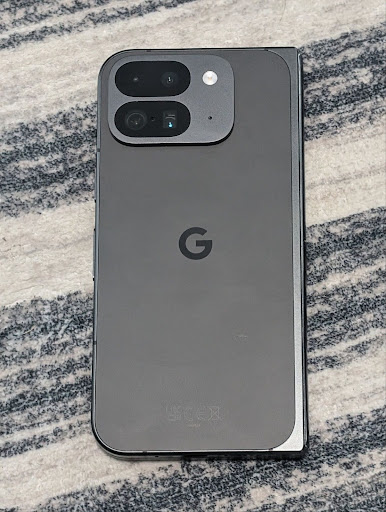
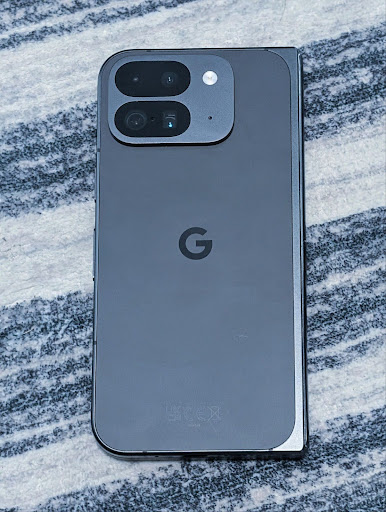
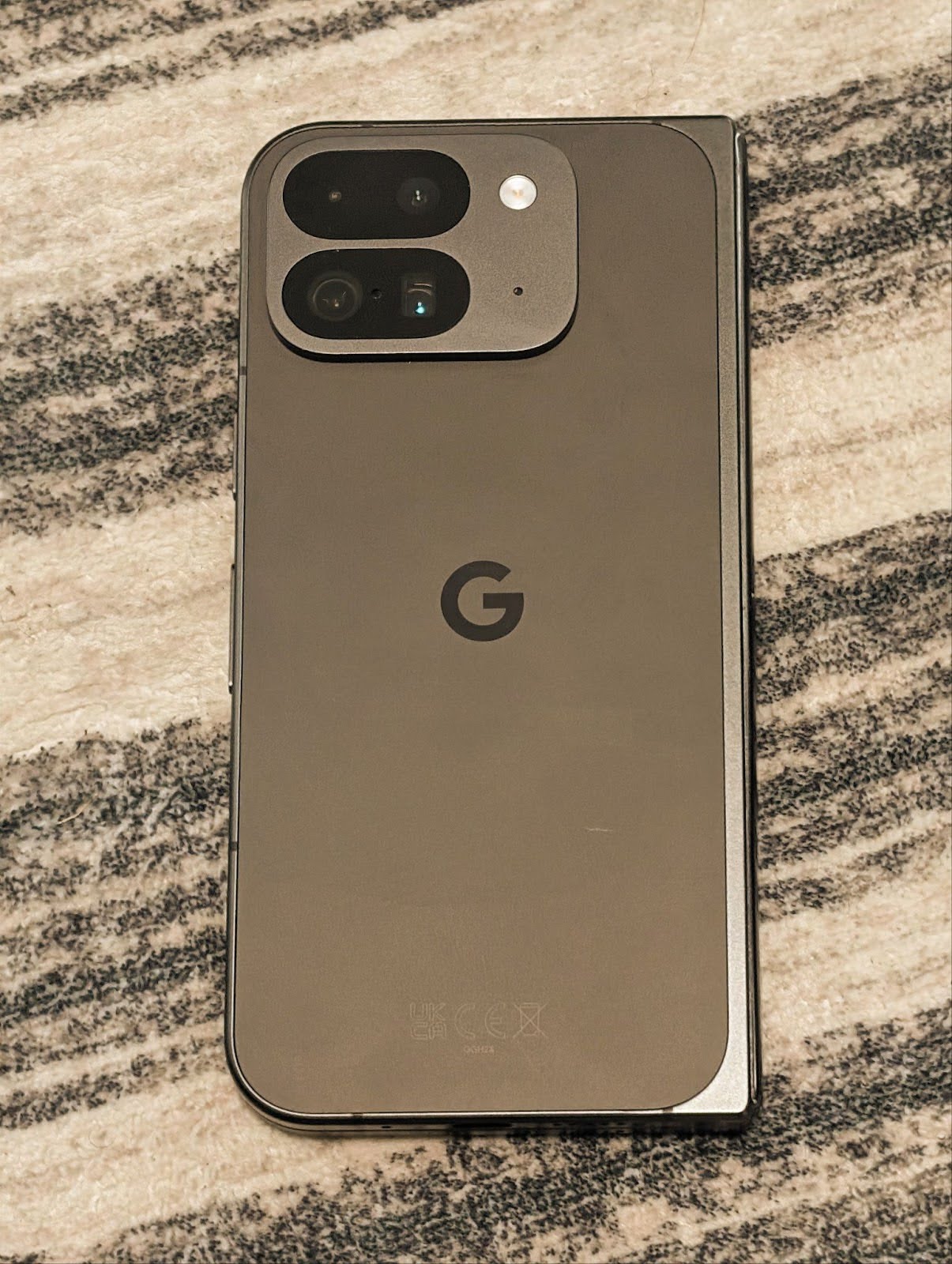
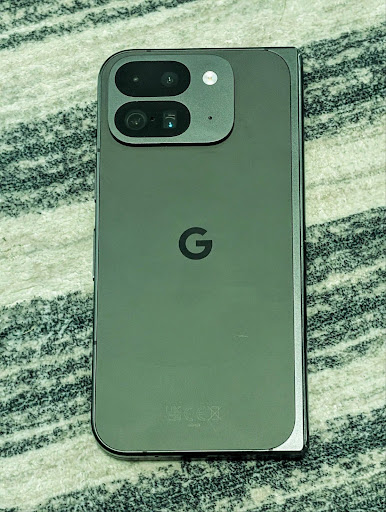

การตรวจหาฉากในโหมดกลางคืนของกล้อง
Android 16 เพิ่ม EXTENSION_NIGHT_MODE_INDICATOR เพื่อช่วยแอปในการระบุเวลาสลับจากและไปยังเซสชันกล้องโหมดกลางคืน หากรองรับ ฟีเจอร์นี้จะอยู่ใน CaptureResult ภายใน Camera2
นี่คือ API ที่เราได้พูดถึงสั้นๆ ว่ากำลังจะเปิดตัวในบล็อกโพสต์วิธีที่ Instagram ช่วยผู้ใช้ให้ถ่ายภาพในที่แสงน้อยได้อย่างน่าทึ่ง โพสต์ดังกล่าวเป็นคำแนะนำที่เป็นประโยชน์เกี่ยวกับวิธีใช้โหมดกลางคืน พร้อมกรณีศึกษาที่เชื่อมโยงรูปภาพในโหมดกลางคืนในแอปที่มีคุณภาพสูงขึ้นกับจำนวนรูปภาพที่แชร์จากกล้องในแอปที่เพิ่มขึ้น
การดำเนินการผ่าน Intent ในการจับภาพเคลื่อนไหว
Android 16 เพิ่มการดำเนินการของ Intent มาตรฐาน ACTION_MOTION_PHOTO_CAPTURE และ ACTION_MOTION_PHOTO_CAPTURE_SECURE ซึ่งจะส่งคําขอให้แอปพลิเคชันกล้องจับภาพเคลื่อนไหวและแสดงผล
คุณต้องส่ง EXTRA_OUTPUT เพิ่มเติมเพื่อควบคุมตำแหน่งที่จะเขียนรูปภาพ หรือส่ง Uri ผ่าน Intent.setClipData(ClipData) หากคุณไม่ได้ตั้งค่า
ClipData ระบบจะคัดลอกค่านั้นให้คุณเมื่อโทรไปที่ Context.startActivity(Intent)
การปรับปรุงรูปภาพ Ultra HDR
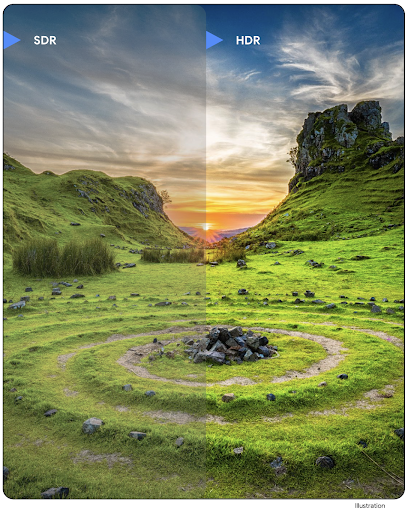
Android 16 สานต่องานของเราในการมอบคุณภาพรูปภาพที่ยอดเยี่ยมด้วยรูปภาพ UltraHDR
โดยเพิ่มการรองรับรูปภาพ UltraHDR ในไฟล์รูปแบบ HEIC รูปภาพเหล่านี้จะได้รับประเภท ImageFormat
HEIC_ULTRAHDR และจะมีแผนที่การขยายสัญญาณที่ฝังอยู่คล้ายกับรูปแบบ UltraHDR JPEG ที่มีอยู่ เรากำลังดำเนินการเพื่อรองรับ AVIF สำหรับ UltraHDR ด้วย โปรดติดตามความคืบหน้าต่อไป
นอกจากนี้ Android 16 ยังใช้พารามิเตอร์เพิ่มเติมใน UltraHDR จากมาตรฐานฉบับร่าง ISO 21496-1 ซึ่งรวมถึงความสามารถในการรับและตั้งค่าพื้นที่สีที่ควรใช้คณิตศาสตร์ของตารางการขยายสัญญาณ รวมถึงการรองรับรูปภาพฐานที่เข้ารหัส HDR ที่มีตารางการขยายสัญญาณ SDR
กราฟิก
Android 16 มีการปรับปรุงกราฟิกล่าสุด เช่น เอฟเฟกต์กราฟิกที่กำหนดเองด้วย AGSL
เอฟเฟกต์กราฟิกที่กำหนดเองด้วย AGSL
Android 16 adds RuntimeColorFilter and
RuntimeXfermode, allowing you to author complex effects like
Threshold, Sepia, and Hue Saturation and apply them to draw calls. Since Android
13, you've been able to use AGSL to create custom
RuntimeShaders that extend Shader. The new API
mirrors this, adding an AGSL-powered RuntimeColorFilter that
extends ColorFilter, and a Xfermode effect that
lets you implement AGSL-based custom compositing and blending between source and
destination pixels.
private val thresholdEffectString = """
uniform half threshold;
half4 main(half4 c) {
half luminosity = dot(c.rgb, half3(0.2126, 0.7152, 0.0722));
half bw = step(threshold, luminosity);
return bw.xxx1 * c.a;
}"""
fun setCustomColorFilter(paint: Paint) {
val filter = RuntimeColorFilter(thresholdEffectString)
filter.setFloatUniform(0.5);
paint.colorFilter = filter
}
การเชื่อมต่อ
Android 16 อัปเดตแพลตฟอร์มเพื่อให้แอปของคุณเข้าถึงความก้าวหน้าล่าสุด ในเทคโนโลยีการสื่อสารและไร้สาย
การวัดระยะที่มีการรักษาความปลอดภัยที่ดียิ่งขึ้น
Android 16 เพิ่มการรองรับฟีเจอร์ด้านความปลอดภัยที่มีประสิทธิภาพในตำแหน่ง Wi-Fi บนอุปกรณ์ที่รองรับ 802.11az ของ Wi-Fi 6 ซึ่งช่วยให้แอปสามารถรวมความแม่นยำที่สูงขึ้น ความสามารถในการปรับขนาดที่มากขึ้น และการกําหนดเวลาแบบไดนามิกของโปรโตคอลเข้ากับการปรับปรุงด้านความปลอดภัย ซึ่งรวมถึงการเข้ารหัสตาม AES-256 และการป้องกันการโจมตี MITM ซึ่งช่วยให้ใช้งานได้อย่างปลอดภัยมากขึ้นใน Use Case ต่างๆ ในระยะใกล้ เช่น ปลดล็อกแล็ปท็อปหรือประตูรถยนต์ 802.11az ผสานรวมกับมาตรฐาน Wi-Fi 6 เพื่อใช้ประโยชน์จากโครงสร้างพื้นฐานและความสามารถของมาตรฐานนี้เพื่อการใช้งานในวงกว้างขึ้นและการติดตั้งใช้งานได้ง่ายขึ้น
API การจัดอันดับทั่วไป
Android 16 includes the new RangingManager, which provides
ways to determine the distance and angle on supported hardware between the local
device and a remote device. RangingManager supports the usage of a variety of
ranging technologies such as BLE channel sounding, BLE RSSI-based ranging, Ultra
Wideband, and Wi-Fi round trip time.
การตรวจหาอุปกรณ์ที่ใช้ร่วมกัน
ใน Android 16 เราจะเปิดตัว API ใหม่สำหรับการเชื่อมโยงบริการของแอปที่ใช้ร่วมกัน บริการจะเชื่อมโยงเมื่อ BLE อยู่ในระยะสัญญาณและบลูทูธเชื่อมต่ออยู่ และบริการจะยกเลิกการเชื่อมโยงเมื่อ BLE อยู่นอกระยะสัญญาณหรือบลูทูธยกเลิกการเชื่อมต่อ แอปจะได้รับการเรียกกลับ 'onDevicePresenceEvent()' ใหม่ตาม DevicePresenceEvent ต่างๆ
ดูรายละเอียดเพิ่มเติมได้ใน 'startObservingDevicePresence(ObservingDevicePresenceRequest)'
สื่อ
Android 16 มีฟีเจอร์มากมายที่ช่วยปรับปรุงประสบการณ์การใช้งานสื่อ
การปรับปรุงเครื่องมือเลือกรูปภาพ
The photo picker provides a safe, built-in way for users to grant your app access to selected images and videos from both local and cloud storage, instead of their entire media library. Using a combination of Modular System Components through Google System Updates and Google Play services, it's supported back to Android 4.4 (API level 19). Integration requires just a few lines of code with the associated Android Jetpack library.
Android 16 includes the following improvements to the photo picker:
- Embedded photo picker: New APIs that enable apps to embed the photo picker into their view hierarchy. This allows it to feel like a more integrated part of the app while still leveraging the process isolation that allows users to select media without the app needing overly broad permissions. To maximize compatibility across platform versions and simplify your integration, you'll want to use the forthcoming Android Jetpack library if you want to integrate the embedded photo picker.
- Cloud search in photo picker: New APIs that enable searching from the cloud media provider for the Android photo picker. Search functionality in the photo picker is coming soon.
วิดีโอระดับมืออาชีพขั้นสูง
Android 16 introduces support for the Advanced Professional Video (APV) codec which is designed to be used for professional level high quality video recording and post production.
The APV codec standard has the following features:
- Perceptually lossless video quality (close to raw video quality)
- Low complexity and high throughput intra-frame-only coding (without pixel domain prediction) to better support editing workflows
- Support for high bit-rate range up to a few Gbps for 2K, 4K and 8K resolution content, enabled by a lightweight entropy coding scheme
- Frame tiling for immersive content and for enabling parallel encoding and decoding
- Support for various chroma sampling formats and bit-depths
- Support for multiple decoding and re-encoding without severe visual quality degradation
- Support multi-view video and auxiliary video like depth, alpha, and preview
- Support for HDR10/10+ and user-defined metadata
A reference implementation of APV is provided through the OpenAPV project. Android 16 will implement support for the APV 422-10 Profile that provides YUV 422 color sampling along with 10-bit encoding and for target bitrates of up to 2Gbps.
ความเป็นส่วนตัว
Android 16 มีฟีเจอร์มากมายที่จะช่วยนักพัฒนาแอปปกป้องความเป็นส่วนตัวของผู้ใช้
ข้อมูลอัปเดตเกี่ยวกับ Health Connect
Health Connect adds ACTIVITY_INTENSITY, a data type defined according to World
Health Organization guidelines around moderate and vigorous activity. Each
record requires the start time, the end time, and whether the activity intensity
is moderate or vigorous.
Health Connect also contains updated APIs supporting medical records. This allows apps to read and write medical records in FHIR format with explicit user consent.
Privacy Sandbox ใน Android
Android 16 มี Privacy Sandbox ใน Android เวอร์ชันล่าสุด ซึ่งเป็นส่วนหนึ่งของความพยายามอย่างต่อเนื่องของเราในการพัฒนาเทคโนโลยีที่ผู้ใช้รู้ว่าความเป็นส่วนตัวของตนได้รับการคุ้มครอง เว็บไซต์ของเรามีข้อมูลเพิ่มเติมเกี่ยวกับโปรแกรมเบต้าสำหรับนักพัฒนาแอป Android ของ Privacy Sandbox เพื่อช่วยให้คุณเริ่มต้นใช้งาน โปรดดูรันไทม์ของ SDK ซึ่งช่วยให้ SDK ทำงานในสภาพแวดล้อมรันไทม์เฉพาะที่แยกจากแอปที่ให้บริการ ซึ่งช่วยเสริมเกราะป้องกันที่มากขึ้นในการเก็บรวบรวมและแชร์ข้อมูลผู้ใช้
ความปลอดภัย
Android 16 มีฟีเจอร์ที่จะช่วยเพิ่มความปลอดภัยของแอปและ ปกป้องข้อมูลของแอป
API การแชร์คีย์
Android 16 adds APIs that support sharing access to
Android Keystore keys with other apps. The new
KeyStoreManager class supports
granting and revoking access to keys
by app uid, and includes an API for apps to access shared
keys.
รูปแบบของอุปกรณ์
Android 16 ช่วยให้แอปของคุณรองรับการใช้ประโยชน์จากรูปแบบ ของ Android ได้อย่างเต็มที่
กรอบคุณภาพของภาพและเสียงที่เป็นมาตรฐานสำหรับทีวี
MediaQualityแพ็กเกจใหม่ใน Android 16 จะแสดงชุด API มาตรฐานสำหรับการเข้าถึงโปรไฟล์เสียงและรูปภาพ รวมถึงการตั้งค่าที่เกี่ยวข้องกับฮาร์ดแวร์ ซึ่งช่วยให้แอปสตรีมมิงสามารถค้นหาโปรไฟล์และนำไปใช้กับสื่อแบบไดนามิกได้
- ภาพยนตร์ที่ผ่านการปรับมาสเตอร์ด้วยช่วงไดนามิกที่กว้างขึ้นต้องใช้ความแม่นยำของสีที่มากขึ้นเพื่อดูรายละเอียดเล็กๆ น้อยๆ ในเงาและปรับให้เข้ากับแสงโดยรอบ ดังนั้นโปรไฟล์ที่ให้ความสำคัญกับความแม่นยำของสีมากกว่าความสว่างจึงอาจเหมาะกว่า
- การแข่งขันกีฬาแบบสดมักจะมาสเตอร์ด้วยช่วงไดนามิกแคบ แต่มักรับชมในเวลากลางวัน ดังนั้นโปรไฟล์ที่ให้ความสำคัญกับความสว่างมากกว่าความถูกต้องของสีจะให้ผลลัพธ์ที่ดีกว่า
- เนื้อหาแบบอินเทอร์แอกทีฟทั้งหมดต้องการการประมวลผลน้อยที่สุดเพื่อลดเวลาในการตอบสนอง และต้องการอัตราเฟรมที่สูงขึ้น ทีวีหลายรุ่นจึงมาพร้อมกับโปรไฟล์เกม
API นี้ช่วยให้แอปสลับระหว่างโปรไฟล์ได้ และผู้ใช้สามารถปรับแต่งทีวีที่รองรับให้เหมาะกับเนื้อหาของตนมากที่สุด
การทำให้เป็นสากล
Android 16 เพิ่มฟีเจอร์และความสามารถที่ช่วยเสริมประสบการณ์ของผู้ใช้ เมื่อใช้อุปกรณ์ในภาษาต่างๆ
ข้อความแนวตั้ง
Android 16 เพิ่มการรองรับระดับล่างสำหรับการแสดงผลและการวัดข้อความในแนวตั้งเพื่อให้บริการรองรับการเขียนแนวตั้งพื้นฐานสำหรับนักพัฒนาไลบรารี ซึ่งมีประโยชน์อย่างยิ่งสำหรับภาษาอย่างภาษาญี่ปุ่นที่ใช้ระบบการเขียนแนวตั้งโดยทั่วไป มีการเพิ่ม Flag ใหม่ VERTICAL_TEXT_FLAG ลงในคลาส Paint เมื่อตั้งค่า Flag นี้โดยใช้ Paint.setFlags API การวัดข้อความของ Paint จะรายงานการเลื่อนแนวตั้งแทนการเลื่อนแนวนอน และ Canvas จะวาดข้อความในแนวตั้ง
val text = "「春は、曙。」"
Box(
Modifier.padding(innerPadding).background(Color.White).fillMaxSize().drawWithContent {
drawIntoCanvas { canvas ->
val paint = Paint().apply { textSize = 64.sp.toPx() }
// Draw text vertically
paint.flags = paint.flags or VERTICAL_TEXT_FLAG
val height = paint.measureText(text)
canvas.nativeCanvas.drawText(
text,
0,
text.length,
size.width / 2,
(size.height - height) / 2,
paint
)
}
}
) {}
การปรับแต่งระบบการวัด
Users can now customize their measurement system in regional preferences within
Settings. The user preference is included as part of the locale code, so you can
register a BroadcastReceiver on
ACTION_LOCALE_CHANGED to handle locale configuration changes when
regional preferences change.
Using formatters can help match the local experience. For example, "0.5 in" in English (United States), is "12,7 mm" for a user who has set their phone to English (Denmark) or who uses their phone in English (United States) with the metric system as the measurement system preference.
To find these settings, open the Settings app and navigate to System > Languages & region.

